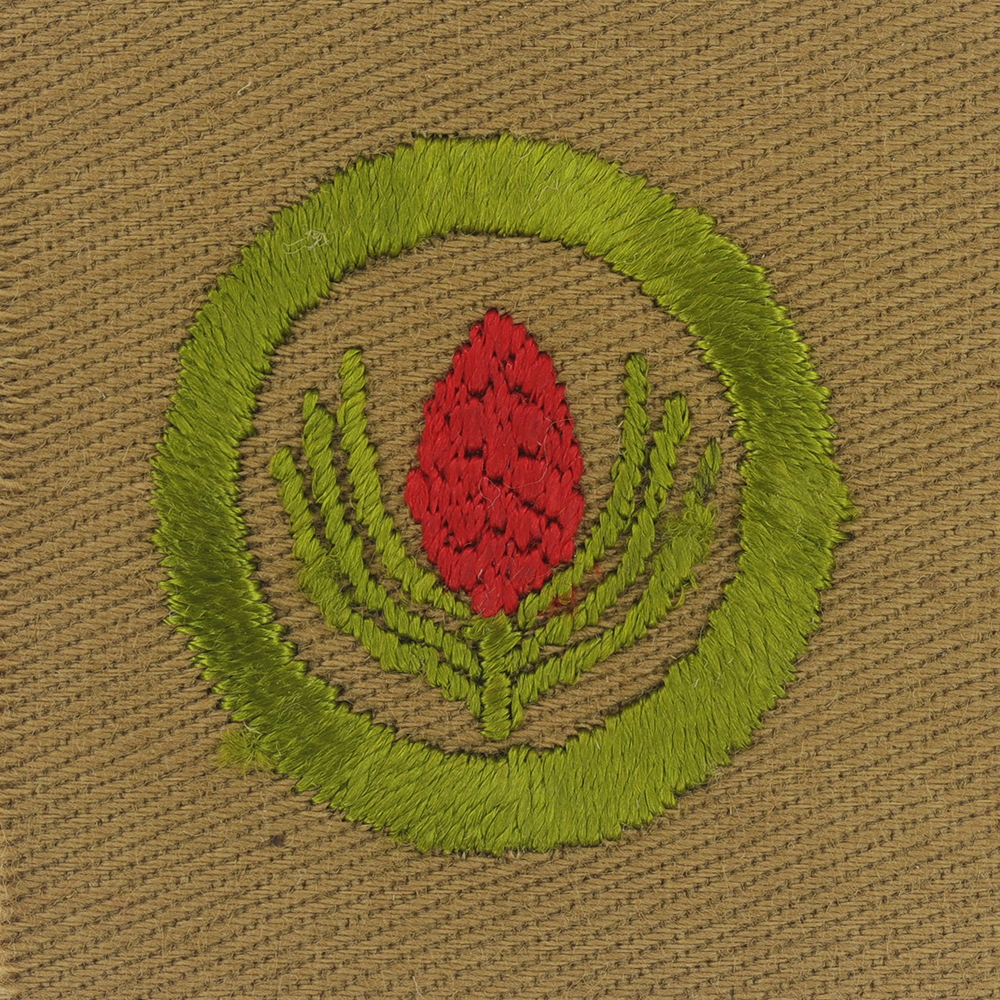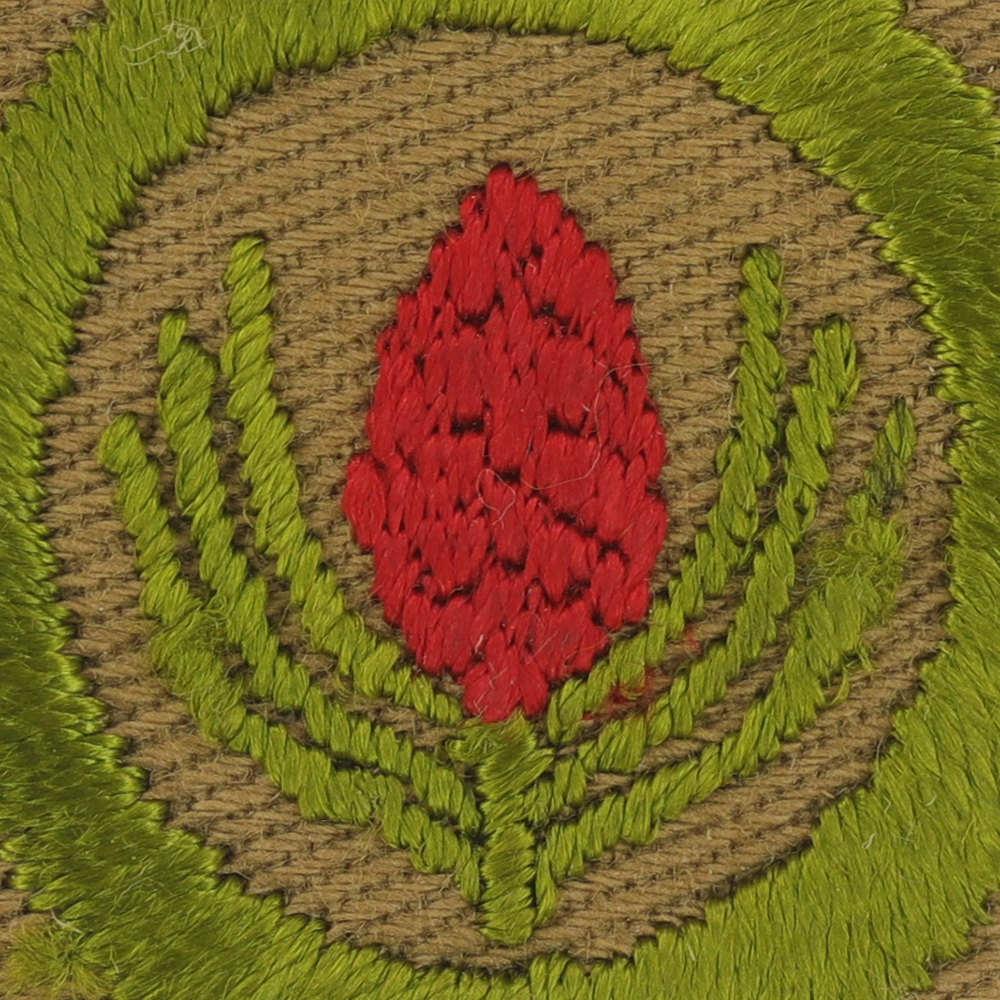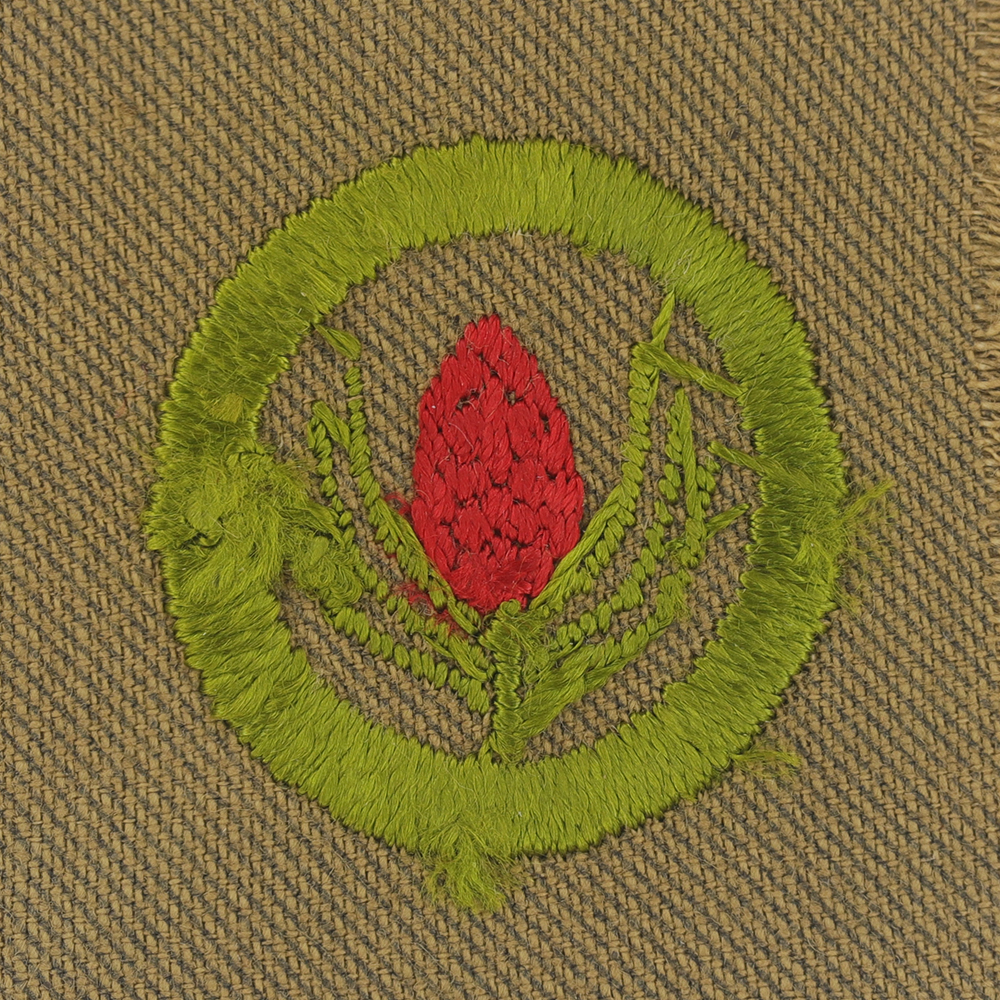
Fig. 1: Forest-AT1-Front
- Cloth: Heavyweight tan right twill
- Embroidery: Silk continuous

Fig. 2: Forest-AT1-Magnified
- Design: Small oval shaped pinecone

Fig. 3: Forest-AT1-Reverse
- Back: Black imprint
Item Name: Forestry 1920 - 1933
Item ID: Forest-AT1
Collector Rating: 1
Pamphlets Used to Earn this Badge
Requirements December 1916 until April 1923
1. Be able to identify twenty-five kinds of trees when in leaf, or fifteen kinds of deciduous (broad leaf) trees in winter, and tell some of the uses of each.
2. Identify twelve kinds of shrubs.
3. Collect and identify samples of ten kinds of wood and be able to tell some of their uses.
4. Determine the height, and estimate the amount of timber, approximately, in five trees of different sizes.
5. State laws for transplanting, grafting, spraying, and protecting trees.
6. Tell what are the effects of fires on forests; what are the three general classes of fires, and how to fight each.
7. Tell how and when to collect tree seeds, how to extract seeds from cones, how to clean and store seeds, how and when to sow seeds, and how to care for seedlings and transplants, and to set them out.
Requirements March 1927 until April 1929
1. Identify twenty-five kinds of trees when in leaf, or fifteen kinds of broad leaf trees in winter.
2. Collect and identify ten different kinds of wood, and be able to tell some uses for each which he himself has observed.
3. Collect and identify seeds of fifteen different kinds of trees.
4. Establish a nursery and grow ten seedlings of each of two needle-leaf trees and of each of two broad-leaf trees, from seed that he himself collected. (Forty seedlings in all.) Tell how the seeds were collected, extracted, and planted.
5. Describe from actual observation (if possible, point out in the woods) the damage that fire does to tree trunks, bark, roots, seedlings (coniferous and broad-leafed).
6. Describe how to build a fire trench to stop a ground fire; describe how to stop a surface fire; how to dispose of limbs and other debris from timber cutting in order to reduce the fire danger; how to locate a forest fire by triangulation.
7. Lay off a plot of one-quarter acre in the woods and tag all trees that should be removed in order that they may be utilized and allow the remaining trees to make better growth or re-seed the forest. Identify each tree and give the reason for removing or leaving it.
8. Present evidence that he has done something specific in furtherance of Forestry, equal in service to one of the following:
(a) Planting 100 trees, preferably seedlings grown by himself.
(b) Thinning or "weeding" (cutting out worthless or inferior species) one-quarter acre of young or medium-aged woodland.
(c) Helping to extinguish a ground and surface fire.
(d) Collecting and burning 500 tent caterpillar egg masses.
Requirements August 1929 until January 1930
1. (a) Identify 25 kinds of trees or shrubs; or
(b) If there are less than 25 such kinds growing within a five mile radius of the Scout's home, identify three-fourths of the different kinds available.
2. Collect and identify ten different kinds of wood and be able to tell some uses for each, which he himself has observed.
3. (a) Collect and identify seeds of 15 different kinds of trees or shrubs, or
(b) If there are less than 20 kinds of trees or shrubs which seed within a five mile radius of the Scout's home, then collect and identify three-fourths of such kinds.
4. Grow 100 tree seedlings through one growing season. Tell how the seeds were obtained and planted.
5. Describe (of if possible, point out in the woods) the damage that fire does to tree trunks, bark, roots and seedlings.
6. Describe how to build a fire trench to stop a ground fire; how to stop a surface fire; how to dispose of limbs and other debris from timber cutting in order to reduce the fire danger.
7. (a) Lay off a plot of one-quarter acre in the woods and tag all trees that should be removed in order that they may be utilized and allow the remaining trees to make better growth or re-seed the forest. Identify each tree and give the reason for removing or leaving it.
(b) Determine the height and diameter of 3 trees; estimate the amount of usable lumber and cordwood in these trees. If trees are not suitable for lumber, estimate for cordwood only.
8. Present evidence that he has done something specific in furtherance of Forestry, equal in service to one of the following:
(a) Planting of 100 trees, preferably seedlings grown by himself.
(b) Thinning or "weeding" (cutting out worthless or inferior species) one-quarter acre of young or medium-aged woodland.
(c) Helping to extinguish a ground or surface fire.
(d) Collecting and burning 50 tent caterpillar or other equally destructive insect egg masses or nests.
Requirements January 1930 until March 1931
1. (a) Identify 25 kinds of trees or shrubs; or
(b) If there are less than 25 such kinds growing within a five mile radius of the Scout's home, identify three-fourths of the different kinds available.
2. Collect and identify ten different kinds of wood and be able to tell some uses for each, which he himself has observed.
3. (a) Collect and identify seeds of 15 different kinds of trees or shrubs, or
(b) If there are less than 20 kinds of trees or shrubs which seed within a five mile radius of the Scout's home, then collect and identify three-fourths of such kinds.
4. Grow 100 tree seedlings through one growing season. Tell how the seeds were obtained and planted.
5. Describe (of if possible, point out in the woods) the damage that fire does to tree trunks, bark, roots and seedlings.
6. Describe how to build a fire trench to stop a ground fire; how to stop a surface fire; how to dispose of limbs and other debris from timber cutting in order to reduce the fire danger.
7. (a) Lay off a plot of one-quarter acre in the woods and tag all trees that should be removed in order that they may be utilized and allow the remaining trees to make better growth or re-seed the forest. Identify each tree and give the reason for removing or leaving it.
OR
(b) Determine the height and diameter of 3 trees; estimate the amount of usable lumber and cordwood in these trees. If trees are not suitable for lumber, estimate for cordwood only.
8. Present evidence that he has done something specific in furtherance of Forestry, equal in service to one of the following:
(a) Planting of 100 trees, preferably seedlings grown by himself.
(b) Thinning or "weeding" (cutting out worthless or inferior species) one-quarter acre of young or medium-aged woodland.
(c) Helping to extinguish a ground or surface fire.
(d) Collecting and burning 50 tent caterpillar or other equally destructive insect egg masses or nests.
Requirements March 1931 until January 1952
1. (a) Identify 15 kinds of trees or shrubs; or
(b) If there are less than 15 such kinds growing within a five mile radius of the Scout's home, identify three-fourths of the different kinds available.
2. Collect and identify ten different kinds of wood and be able to tell some uses for each, which he himself has observed.
3. (a) Collect and identify seeds of 10 different kinds of trees or shrubs, or
(b) If there are less than 10 kinds of trees or shrubs which seed within a five mile radius of the Scout's home, then collect and identify three-fourths of such kinds.
4. Describe (of if possible, point out in the woods) the damage that fire does to tree trunks, bark, roots and seedlings.
5. Describe how to fight and stop a surface fire, or a ground fire is such occurs within his region, and tell the chief causes of forest fire.
6. Measure the heights and diameters of three good sized trees, report measurements, and describe the methods used.
7. Present evidence that he has done something specific in furtherance of forestry, equal in service to one of the following:
(a) Planting 100 trees, preferably seedlings grown by himself.
(b) Thinning or "weeding" (cutting out worthless or inferior species) one-quarter acre of young or medium-aged woodland.
(c) Helping to extinguish a forest or woods fire, or reporting same to some responsible person.
(d) Collecting and burning fifty tent caterpillar or other equally destructive insect egg masses or nests.



